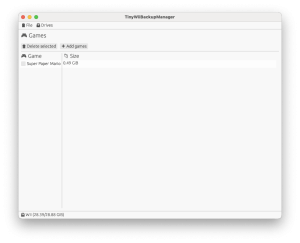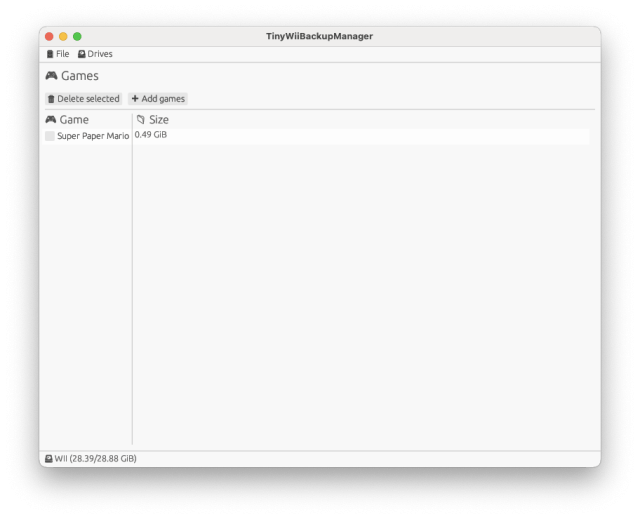More actions
| TinyWiiBackupManager | |
|---|---|
 | |
| General | |
| Author | mq1 |
| Type | PC Utilities |
| Version | 0.1.1 |
| License | GPL-2.0 |
| Last Updated | 2023/10/08 |
| Links | |
| Download | |
| Website | |
| Source | |
TinyWiiBackupManager is a simple WBFS manager written in Rust.
Setting up the drive
Warning - this will delete ALL data on the device!
MacOS
- Open the Disk Utility app (Applications -> Utilities)
- Use CMD+2 to make sure physical devices are visible
- Pick the USB drive from the sidebar
- From the toolbar select Erase
- Name the drive a meaningful name (like WII), please make sure the format is "MS-DOS (FAT)" and the scheme is "Master Boot Record"
- Click on the "Erase" button
Windows
- Download Rufus from https://rufus.ie/, choose the portable version
- On "Device" select your drive
- On "Boot selection" pick "Not bootable"
- Choose a meaningful name (like WII) and put it into the "Volume label" box
- On "File System" pick "FAT32"
- Click on the "START" button
Linux (GNOME)
- Open the Disks app
- Click on your drive in the left sidebar
- Click on the menu (three vertical dots in the top-left of the window) and select "Format Disk"
- Make sure Erase is set to Quick and Partitioning is set to MBR/DOS and click "Format"
- Under "Volumes" for your device, click on the "+" button
- Click "Next"
- Choose a meaningful name (like WII) and put it into the "Volume Name" box
- On "Type", choose "For use with all systems and devices (FAT)
- Click "Next" and then "Format"
Linux (KDE)
- Open KDE Partition Manager
- Click on your device in the left sidebar
- Click on "New Partition Table"
- Select "MS-Dos" and click on "Create New Partition Table"
- Click on "unallocated" and then on "New"
- On "File System" select fat32
- Choose a meaningful name (like WII) and put it into the "Label" box
- Click "OK" and then "Apply"
Screenshots
Changelog
v0.1.1
- Refactoring.
v0.1.0
- First Release.

